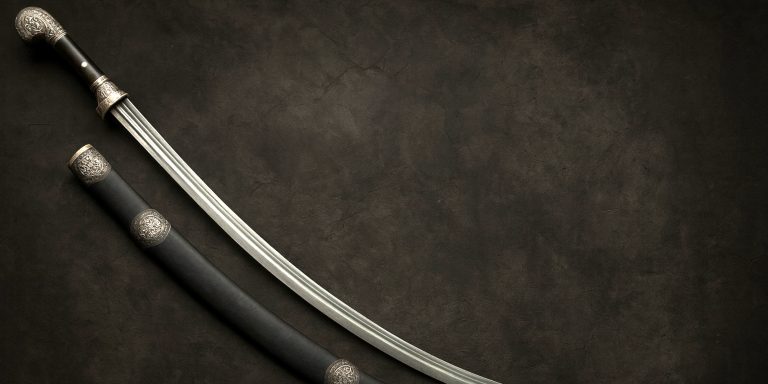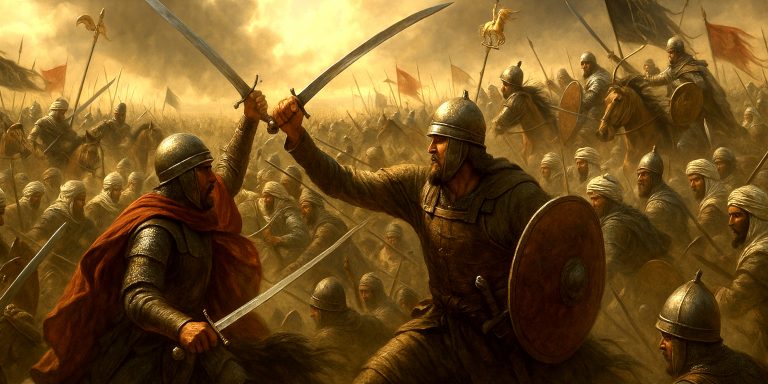
Among the most distinctive weapons of Central Africa, the Azande throwing sword is a remarkable combination of artistry and lethality. Known locally as kpinga, it served not only as a weapon of war but also as a symbol of rank and prestige within Azande society. With its elaborate multiple blades and unique silhouette, it stands apart from the straight-edged weapons of Europe and Asia.
This article explores everything we know about the Azande throwing sword, including its specifications, origins, strengths and weaknesses, and its continuing legacy as a highly collectible weapon of African heritage.
Specifications
| Feature | Description |
|---|---|
| Name | Azande Throwing Sword (Kpinga) |
| Origin | Central Africa, primarily used by the Azande (Zande) people of the Congo, South Sudan, and Central African Republic |
| Period of Use | 18th to early 20th centuries |
| Material | Forged iron or steel, often with leather or fibre-wrapped handle |
| Length | Typically 45–60 cm (18–24 inches) |
| Weight | Around 0.5–1 kg |
| Design | Multiple projecting blades (usually 3–5) radiating from a central spine, each with sharpened edges and points |
| Function | Primarily a throwing weapon; secondary use in close combat |
| Range | Effective up to 20–30 metres when thrown by an experienced warrior |
History and Evolution
The Azande throwing sword developed within a broader tradition of African bladed weapons that blurred the line between utility, ceremony, and warfare.
- Origins: The weapon’s form evolved from earlier Central African ironworking traditions, influenced by both indigenous craftsmanship and trade networks. Iron was a marker of wealth and authority, and the forging of such complex shapes demonstrated a smith’s mastery.
- Cultural Role: Among the Azande, the kpinga was carried only by warriors of proven status. It was often presented by a king or chief as a mark of honour and could signify initiation into the warrior elite.
- Combat Use: Although designed for throwing, the kpinga could be used in melee combat. Warriors carried several in a belt and hurled them before engaging hand-to-hand. The multiple blades increased the likelihood of a hit and inflicted grievous wounds.
- Colonial Era and Decline: By the late 19th century, European colonisation, trade restrictions, and the introduction of firearms led to the decline of traditional African weaponry. The kpinga gradually became a ceremonial or decorative object, its martial role replaced by symbolic use in dance and ritual.
Advantages and Disadvantages
| Advantages | Disadvantages |
|---|---|
| Multiple blades increase hit probability and wound severity. | Requires extensive training to throw accurately. |
| Effective both at short-range and in close combat. | Limited range compared to spears or arrows. |
| Compact and easy to carry, often multiple per warrior. | Easily damaged if striking hard surfaces. |
| Distinctive design made it a psychological weapon in battle. | Complex shape made forging and repair difficult. |
Comparison with Similar Weapons
| Weapon | Region | Similarities | Differences |
|---|---|---|---|
| Hunga Munga | Central and West Africa (Mangbetu, Ngombe, Zande) | Similar multi-bladed throwing weapon used for war and ceremony. | The kpinga is more symmetrical and refined in form, often with a triangular central blade. |
| Shongo Throwing Knife | Congo Basin | Used by chiefs and warriors as a status weapon. | Shorter range, more curved blades, heavier for hand use. |
| European Throwing Axe (Francisca) | Western Europe (Franks) | Used as a ranged melee weapon. | Single edge and functional simplicity; lacks ceremonial purpose. |
| Boomerang (Australian Aboriginal) | Australia | Thrown weapon relying on aerodynamic flight. | Designed to return (in some types); not a bladed weapon. |
Legacy
The Azande throwing sword is now recognised as one of the finest examples of African ironwork and ingenuity. Its elaborate form reflects both the technical skill of African blacksmiths and the cultural complexity of warrior societies in Central Africa.
Today, it appears frequently in ethnographic museums and private collections, representing both artistry and status. In academic circles, the kpinga has become a key example in discussions of African metallurgy, symbolic weaponry, and the intersection of art and warfare.
Where to See
Notable examples of Azande throwing swords can be found in:
- British Museum (London, UK) – Several finely preserved kpinga examples with catalogued provenance.
- Musée du quai Branly (Paris, France) – Collection of Central African weapons, including Azande swords.
- Royal Museum for Central Africa (Tervuren, Belgium) – Extensive holdings from colonial Congo.
- Metropolitan Museum of Art (New York, USA) – Occasional display in African Arms and Armour exhibits.
Collectors Guide
Collectibility and Rarity:
- Authentic kpinga swords are highly sought after, especially examples with clear provenance and minimal corrosion.
- Variations in blade shape and forging detail influence value significantly.
- Ritual versions made post-contact (late 19th–early 20th century) are more common and less valuable than pre-colonial examples.
Estimated Auction Prices:
| Condition | Estimated Price Range (GBP) | Notes |
|---|---|---|
| Excellent (museum-quality) | £2,000–£4,000 | Complete, minimal rust, verified 19th-century origin. |
| Good (collector-grade) | £800–£1,500 | Intact blades with minor wear. |
| Fair (display quality) | £300–£700 | Corrosion, partial damage, or uncertain provenance. |
| Reproduction or Late Ceremonial | £100–£300 | Modern copies or decorative versions. |
Market Insights:
- Provenance linked to colonial expeditions or early ethnographic collections raises value.
- Beware of over-cleaned examples, which lose historical patina.
- Reproductions are increasingly common; authentic examples exhibit asymmetrical hand-forging marks and layered iron textures.
The Seven Swords Takeaway
The Azande throwing sword is a weapon of extraordinary craftsmanship and cultural significance. Blending artistry, symbolism, and practical design, it reflects a society where warfare, ceremony, and identity were closely intertwined. Its unique silhouette continues to fascinate collectors and historians alike, standing as a reminder of the diversity and sophistication of African metallurgical traditions.



